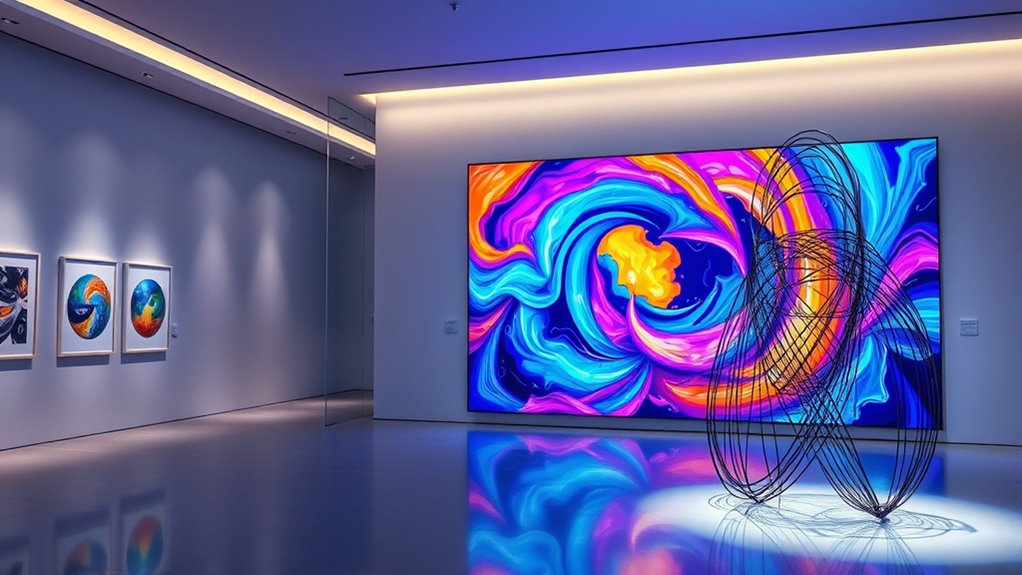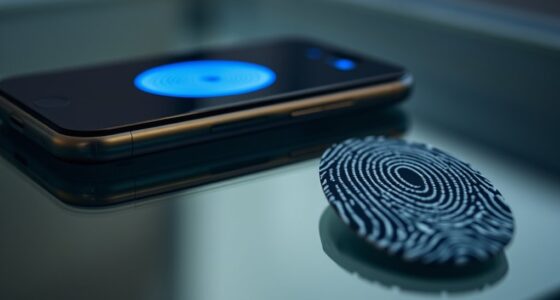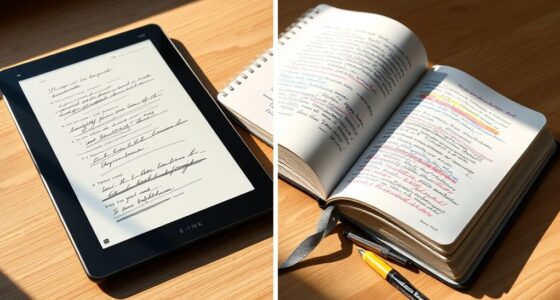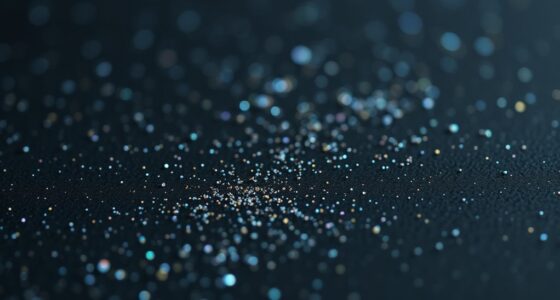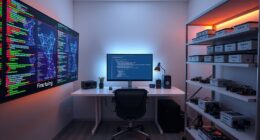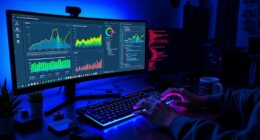AI-generated art blurs the line between creativity and copying by mimicking styles through data analysis and pattern recognition, but it lacks true human intention and emotional depth. While AI can produce visually compelling work, it doesn’t generate genuine originality or personal meaning like human artists do. Ethical questions about authorship and authenticity also arise. To understand how AI impacts artistic innovation and if it’s truly creative, explore further into the evolving discussions around AI in art.
Key Takeaways
- AI art primarily mimics existing styles, raising questions about whether it creates genuinely new work or simply copies.
- True creativity involves human intention and emotional depth, which AI lacks despite technical mimicry.
- Many AI-generated works are collaborative efforts, blending human input with machine processing, challenging notions of originality.
- Ownership and authorship rights are ambiguous, often making AI art seem derivative rather than inherently creative.
- Ethical concerns about data sources and the potential for unoriginal, derivative outputs influence perceptions of AI art as copy versus creativity.
What Defines Artistic Creativity?
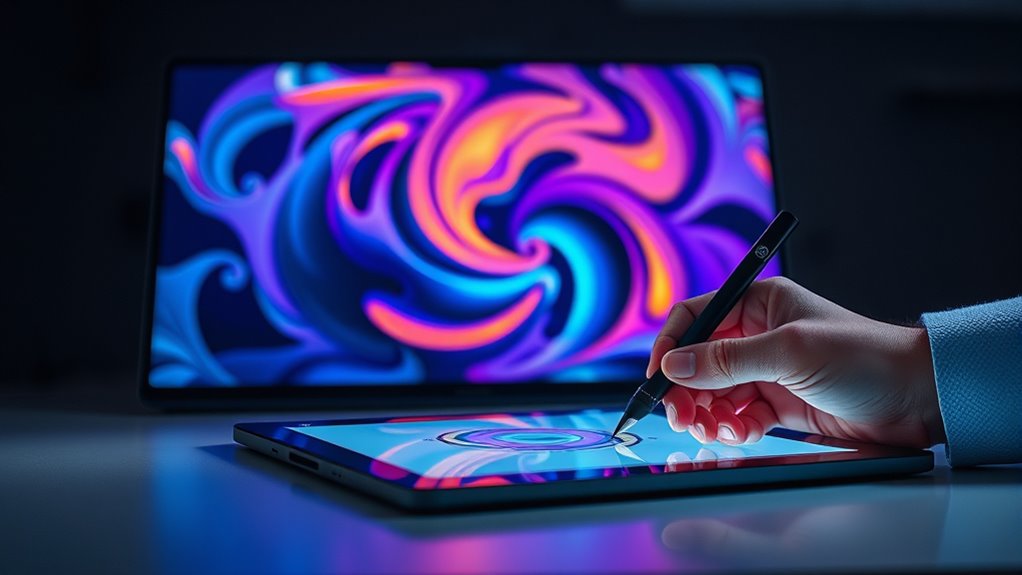
What exactly makes a work of art truly creative? It’s all about originality and value. You use your imagination to craft ideas or works that are fresh and meaningful, standing out from mere imitation. Artistic creativity involves inventing new styles, techniques, or forms, pushing boundaries beyond traditional norms. It’s not just about copying; it’s about expressing yourself uniquely through art, whether in painting, music, dance, or other forms. Your work should also carry some kind of value—whether aesthetic, emotional, or intellectual—that resonates with others. Creativity is a dynamic process, requiring ongoing effort, practice, and a willingness to take risks. Additionally, understanding artistic techniques can help artists develop their unique voice and enhance their creative processes. Recognizing different artistic styles can also inspire innovation and broaden an artist’s expressive capabilities. Exploring creative inspirations from various sources can further enrich artistic expression. Engaging with hackathons, especially those that promote collaboration and diverse thinking, can also stimulate new ideas and approaches in creative work. Incorporating insights from sound healing science and other innovative fields can open new avenues for artistic exploration. Ultimately, it’s about producing something that reflects your individual vision while contributing to the broader cultural landscape.
The Role of Human Intention and Emotion
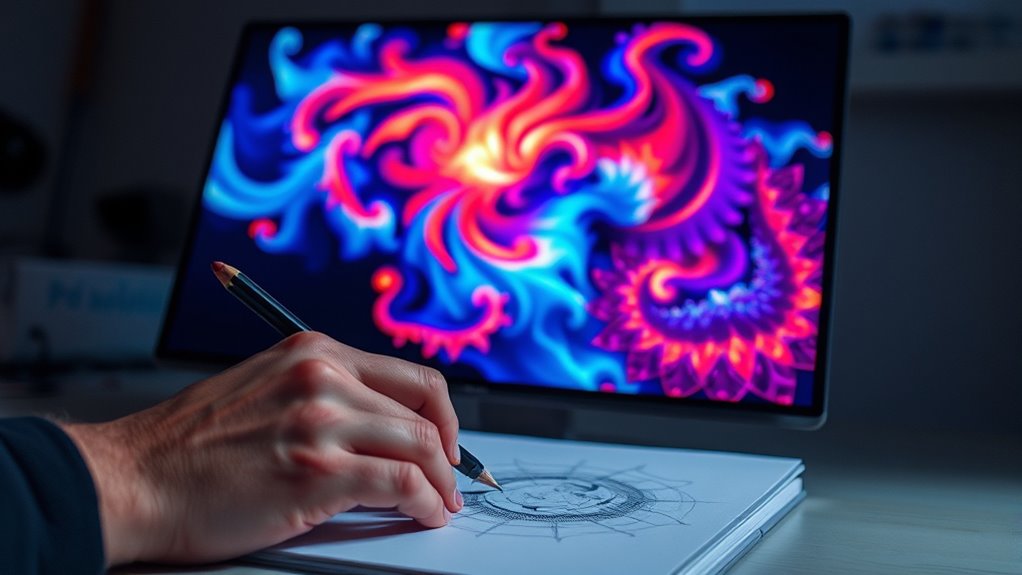
Human intention and emotion are central to the creation and perception of art, shaping how works are understood and valued. You might notice that AI-generated art can evoke strong feelings, sometimes even more than human-made pieces, especially when you collaborate with the technology. People tend to attribute intentions and emotions to AI art, similar to their reactions to human creations, although they often feel a deeper emotional connection to art made by humans. Your awareness that an artwork was created by a machine can influence your emotional response, either diminishing or heightening its impact. When you know humans guide AI processes, your perception of emotional depth increases. Additionally, the artistic process, including human involvement, plays a key role in conveying authenticity and emotional resonance in AI-generated works. Recognizing that the creation process involves both technological and human elements helps deepen your understanding of the artwork’s significance. The personality traits of the human creators can influence how their intentions are embedded into the art. Ultimately, human intention remains crucial in shaping the emotional resonance and meaning behind art, even when machines are involved. Moreover, understanding the tools and techniques used in creating AI art can enhance your appreciation of the collaborative effort between human creativity and technology. Considering the appliance maintenance aspect, ensuring that digital tools and hardware are functioning properly can also impact the quality of AI-generated art.
How AI Mimics Artistic Styles and Patterns

AI creates art by analyzing and replicating the stylistic features found in large collections of existing artworks. It uses generative models like GANs and diffusion models to learn from vast datasets, capturing patterns in brushwork, textures, and color schemes. Style transfer techniques allow AI to apply the stylistic essence of one image onto another, mimicking artistic details without recreating the whole composition. Fine-tuning pre-trained models on a small number of works enables AI to replicate specific artists’ styles more precisely. Prompt engineering guides text-to-image models to produce desired styles without retraining. Because AI relies on statistical learning and pattern recognition, it decomposes styles into quantifiable visual elements, allowing it to generate images that closely resemble original techniques, sometimes blurring the line between imitation and genuine creativity. This process highlights the importance of understanding artistic styles as complex and nuanced, which AI can approximate but not fully replicate with human depth. Recognizing these technological limitations is essential for appreciating the true scope of AI’s creative capabilities. Additionally, the development of ethical considerations is crucial as AI-generated art raises questions about originality and authorship. Moreover, ongoing research into AI security is vital to prevent misuse or malicious manipulation of generated images.
The Question of Originality and Innovation
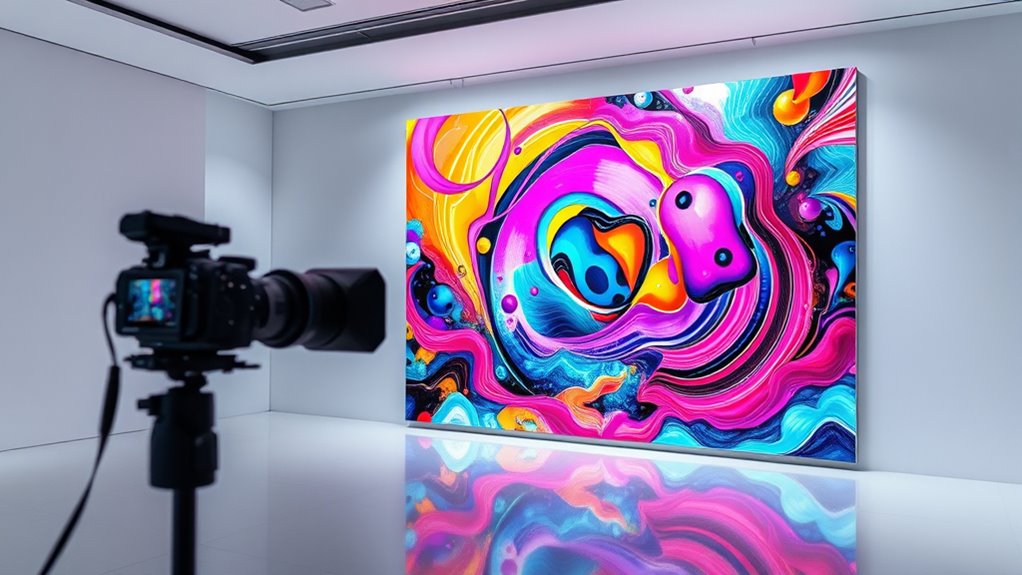
The question of originality and innovation in AI-generated art hinges on how we define creativity itself. Traditional art relies on novelty, personal input, and expressiveness, but AI produces work by analyzing vast datasets of existing images, raising doubts about true novelty. Most AI art is a collaboration with human input, not purely machine-driven, yet AI lacks intentionality—an essential aspect of originality. Legally, originality depends on human authorship, complicating how AI works are classified. Public perception remains skeptical; many see AI art as derivative or lacking genuine creativity. Despite this, the market’s rapid growth and high-value sales suggest a different view—one that values asset division, innovation and commercial appeal, even amid ongoing debates about whether AI can truly innovate or merely copy.
Ethical Dilemmas in AI Art Creation
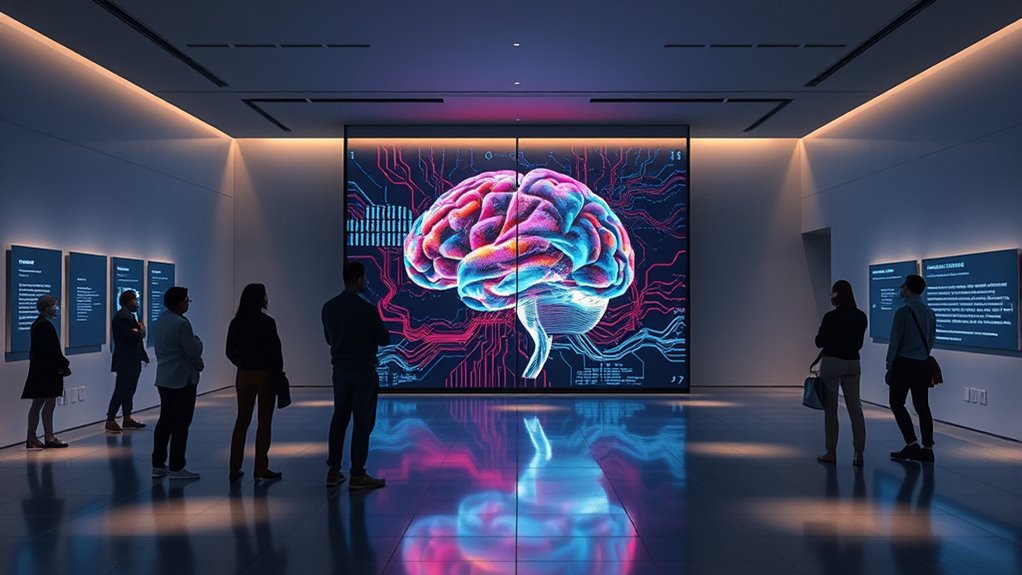
As AI-generated art continues to grow in popularity and commercial value, ethical questions about its creation become more pressing. Ownership and authorship are unclear—who owns the rights when AI produces art? Copyright laws struggle to define if the work is original or derivative, risking the rights of original artists whose work trains AI systems. Transparency is also essential; creators and companies must disclose algorithms and data sources to maintain trust. Privacy concerns arise when personal or copyrighted images are used without consent, infringing on individuals’ rights. Additionally, biases in training data can reinforce stereotypes or misrepresent cultures. Without clear guidelines, there’s a risk of misuse, deception, or unfair profit distribution, raising serious ethical dilemmas about the legitimacy and fairness of AI-generated art. Ensuring the Vetted – Mother Baby Kids standards are applied to AI art creation processes could help promote ethical practices and protect original creators.
The Impact of AI on the Artistic Community
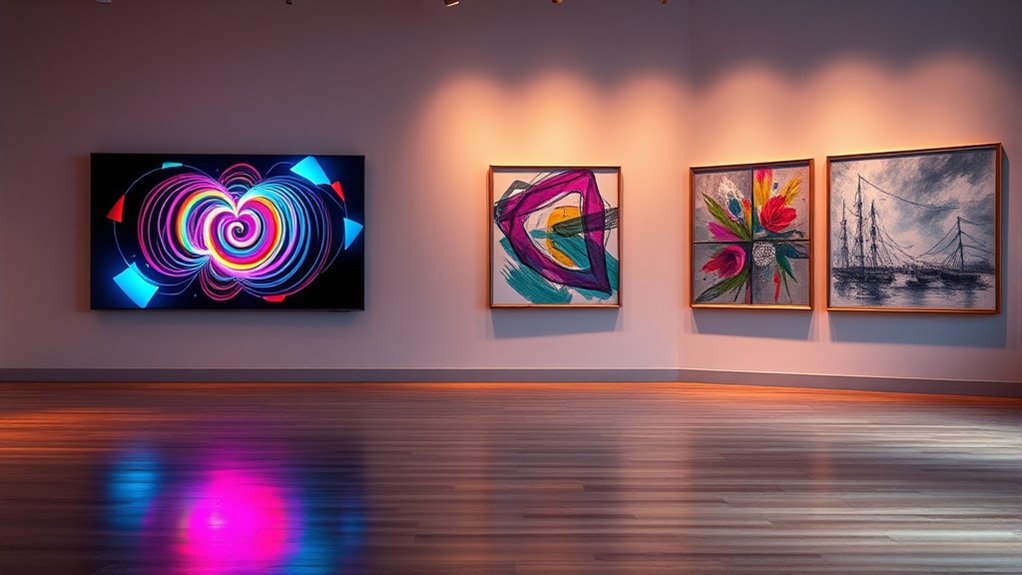
AI is transforming the artistic community by making art creation faster and more accessible, challenging traditional notions of skill and ownership. You can produce complex pieces in minutes, bypassing years of training, which raises questions about artistic effort and credibility. Ownership disputes arise when AI-generated works are claimed solely by users, threatening established norms of authorship. This shift democratizes art, allowing more diverse voices to participate and innovate, but it also risks marginalizing traditional artists who feel their skills are undervalued. AI tools support creators by inspiring new ideas and expanding creative boundaries, blending human intuition with machine intelligence. Additionally, the integration of high-quality projector technology into art displays can enhance the visual impact of AI-generated works, further influencing market and cultural perceptions. As AI influences market and cultural perceptions, the community faces ongoing debates over recognition, authenticity, and the evolving meaning of artistic value. Moreover, the rise of innovative unique and wicked planters demonstrates how technology and creativity can intersect to inspire new forms of artistic expression beyond traditional media. Furthermore, understanding digital asset management can help artists and collectors navigate ownership rights and provenance issues in this evolving landscape. Recognizing the importance of artistic skill development remains essential as technology continues to reshape the creative process. As these AI-driven innovations become more prevalent, the importance of ethical considerations in art creation is increasingly recognized to ensure responsible use of technology.
Future Perspectives: Collaboration or Competition?
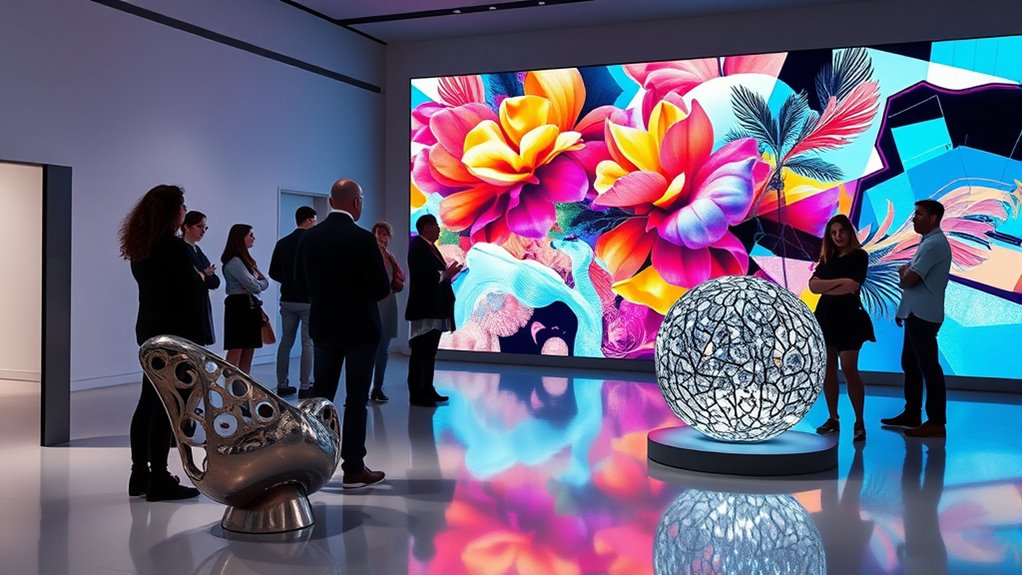
AI’s growing influence in art sparks a debate about whether it will serve as a collaborative partner or a formidable competitor for human artists. On one hand, AI enables new art forms by blending traditional methods with digital tech, expanding creative possibilities. Collaborating with AI can inspire fresh ideas and push artistic boundaries, leading to groundbreaking work. AI tools democratize art, making it more accessible and fostering innovation. As technology advances, AI-generated art becomes more realistic and visually stunning, challenging traditional notions of authorship. Additionally, understanding grocery store hours can help artists plan their supplies and logistics more effectively. This awareness ties into broader privacy policies that regulate data collection and user consent, which increasingly impact digital art platforms. Furthermore, developments in machine learning algorithms have expanded the potential for AI to generate unique and complex artworks, raising questions about the role of human creativity. These advancements also influence intellectual property rights, complicating issues of ownership and originality. However, this progress also disrupts markets and raises ethical questions about ownership and originality. Moreover, AI can either complement your creativity, opening new horizons, or threaten your role in the artistic landscape—depending on how you choose to collaborate or compete.
Frequently Asked Questions
Can AI Art Truly Evoke Human Emotional Responses?
You might wonder if AI art can truly evoke human emotions. Research shows it can, often matching or even surpassing responses to human-made art. When you see AI-generated pieces, your emotional connection forms through shared creativity and perception of intent. Even knowing it’s AI, your feelings can be strong, and subtle differences in emotional depth exist. AI art proves it’s capable of touching your feelings, blurring the lines between technology and human expression.
Who Holds Copyright Rights for Ai-Generated Artworks?
You might wonder who holds copyright rights for AI-generated artworks. Currently, if no human contributes creatively, the work isn’t eligible for copyright and falls into the public domain. When you use AI as a tool with some human input—like selecting or arranging—you could own the copyright. However, if AI acts independently, no one owns the rights, making legal ownership unclear and challenging to enforce.
How Does AI Learn and Interpret Artistic Styles?
You’re asking how AI learns and interprets artistic styles, and it’s like witnessing a superpower in action! Your AI combs through enormous, diverse datasets, extracting textures, colors, and techniques. It then separates style from content, blending influences seamlessly—sometimes creating wild hybrids! From watercolor to cubism, your AI mimics, adapts, and even innovates, but it still relies on patterns learned from human art, making it a remarkable imitator, not a true creator.
Is AI Capable of Genuine Creative Innovation?
You wonder if AI can truly innovate creatively. While AI can generate novel ideas by analyzing large datasets and combining styles, it lacks personal experience and emotional depth. You’ll find that AI acts as a tool to enhance your creativity, not replace it. It offers inspiration and new possibilities, but genuine innovation still relies on your human insight, intentionality, and ability to infuse art with meaning and cultural context.
Will AI Replace Human Artists in the Future?
You might wonder if AI will replace human artists in the future. While AI can assist and create impressive works, it lacks true intentionality and emotional depth that human artists bring. People still prefer human-created art for its authenticity and personal stories. Instead of replacing, AI is more likely to serve as a tool, enhancing your creativity and opening new horizons for collaboration and innovation in art.
Conclusion
As we navigate the evolving landscape of AI art, it’s like strolling through a garden where new blooms gently blend with familiar flowers. While questions of originality linger, embracing AI’s creative whispers can open doors to fresh inspiration. Instead of replacing human touch, it offers a subtle harmony—an invitation to explore, collaborate, and deepen your artistic journey. In this gentle dance, the future holds a promise of endless, nuanced beauty waiting to be discovered.
